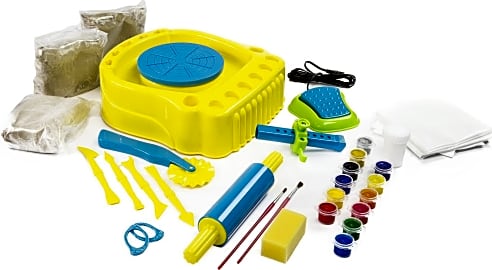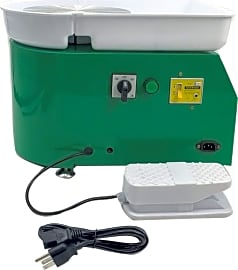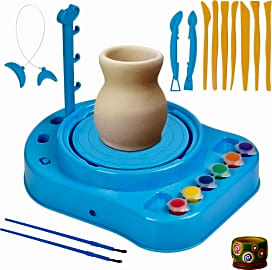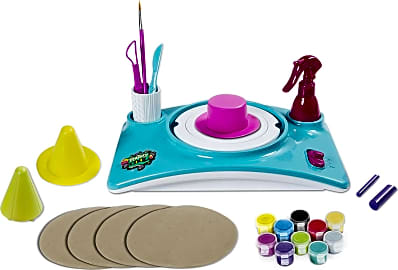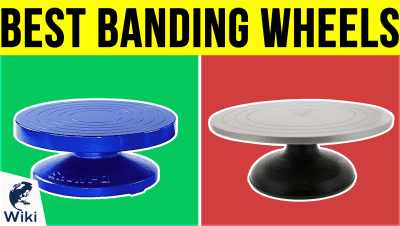The 9 Best Pottery Wheels

This wiki has been updated 42 times since it was first published in September of 2015. Crafting with clay can be a very satisfying way to express your creativity and to produce some unique items. Our assortment of pottery wheels includes everything from playful options to spark your children's interest to inexpensive models for beginners and those on a budget, as well as some heavier-duty units for serious artisans that will stand up to daily use for years to come. When users buy our independently chosen editorial recommendations, we may earn commissions to help fund the Wiki.
Editor's Notes
July 20, 2020:
One of the great things about ceramics is it's an ancient craft that doesn't change much, nor does the equipment needed to participate in it. With that in mind, most of the items on this ranking still earn their spots, save for the U.S. Art Supply Table Top, which we removed because it was too pricey considering that the splash pan was too small, and it could only fit the one, brand-specific bat. We replaced it with the Cozyel 25cm Electric, which can't fit bats at all but provides ample power and is so budget friendly that we felt it was a reasonable trade.
The biggest change to this list is that we added a few new models to the mix. The Hukoer Mini Turntable is suitable for the hobbyist who wants to create small pieces at home. One drawback is that it doesn't include a foot pedal, so you have to adjust speeds by hand, which can be inconvenient. But overall, it's a fun little gadget. We also added the Wowoss Ceramic Machine, a good introduction for children that gives them a chance to experiment with throwing and complements the other toy offerings on this list.
Of course, throwing is just the beginning of a bowl, vase, or cup's journey. To shape, decorate, or add things like handles, we recommend investing in a complete set of hand tools, like those found on our clay sculpting tools ranking. For more professional ceramicists looking to invest in additional equipment, our banding wheels ranking might also be of interest.
May 24, 2019:
Creating with clay can be a rewarding hobby for children and adults alike, so we tailored our selections to reflect the wide ranges and of age and ability potential artists might be shopping for.
The Speedball Big Boss and Brent IE models are intended for the already dedicated artisan who has been taking classes and would like to set up an in home studio to further their craft and possibly make pieces to give away or sell. These units are a significant investment but will last for years and turn out professional quality pieces.
The table top models like the Speedball Artista Portable don't offer as much power as the free-standing options, but can still turn out beautiful pieces for those who don't have a dedicated space for their craft.
The children's options are definitely toy quality and are ideal for finding out if your child has a real interest in this craft before investing in the real deal.
Special Honors
Shimpo VL Whispter If near-silent function is a requirement for you to find your zen while throwing a pot, the Shimpo brand is well-known for being the quietest wheels on the market. It's similar in price and quality to other high-end wheels for the home studio, but starts to lose torque once you place more than 20 pounds of clay on it, even though it's rated for up to 100 pounds. sheffield-pottery.com
Wheels Of Fortune
In a hundred years, you won't be here anymore, but the stone will be, albeit further changed by time.
How do you talk about pottery wheels and not talk about the 1990 romantic drama Ghost starring Patrick Swayze, Demi Moore, and Whoopi Goldberg, which contains the single most memorable pottery scene in film history? Easy! You talk about Japanese aesthetics instead.
One of the dominant aesthetic perspectives in Japanese art resides in a concept known as wabi-sabi. Wabi-sabi places an emphasis on imperfection, impermanence, and transience. Essentially, the perfection of the world and our experience of it lies in its flaws. A stone is not perfect because it's made with flawless symmetry; it's perfect because time and materials have weathered it to be the imperfect stone you meet today on this walk in the park.
In a hundred years, you won't be here anymore, but the stone will be, albeit further changed by time. The aesthetic is grounded in the Buddhist world view that holds to no constant present other than the present moment. In the absolute present there can be no constant because a constant implies both a future and a past.
Okay, so what does that have to do with pottery? Well, the pottery wheels on our list all give you the opportunity to experiment with this aesthetic. Some schools of pottery design might have you sweating over the straightness of a line here or the curve of the bowl there, but if you plop some clay down on any of these wheels and get it turning, either by the electric motor and belt so many of them use, or by turning slowly and manually, you can shape and refine your pottery to perfect imperfection. In the Japanese pottery schools, a mistake here or there is not only forgivable, it's celebrated.
There are a few options on our list that are more clearly for beginners or children, and the rest could easily belong to the most refined professionals in the discipline. What's important for you to know is that, as the pottery wheel spins, so too spins the wheel of life. A good piece of pottery starts out in the middle of the wheel, so roll up your sleeves, pop on your cassette tape of The Righteous Brothers singing Unchained Melody and get those hands dirty.
Pottery For Everybody
Craftsmanship in pottery making is a lot like craftsmanship in other artistic disciplines such as painting of even photography. You can't necessarily evaluate the artist's performance based on the gear used.
In photography, for example, some of the most impressive, award-winning shots come from amateurs shooting with entry-level D-LSRs that cost a fraction of what the pros use. In painting, too, one rarely compliments a beautiful painting only to have his or her opinion turn on a dime upon realizing that it was made with acrylics and not water colors.
A fine craftsman can throw a gorgeous, sturdy piece of pottery on the kids' wheels we've listed.
When it comes to pottery, the particulars of the clay and the wheel are immaterial when handling the final product. A fine craftsman can throw a gorgeous, sturdy piece of pottery on the kids' wheels we've listed. The funny thing is that the craftsman in question would have as hard a time using that kids' wheel as a beginner might have with a professional wheel.
Take stock of your experience level as you peruse the options on our list. If the wheel is for you, and you're new to the game, the wheels on our list that are automatic, but a little smaller–even if that means it's a kids' model–would be ideal. If you have a few more miles on the wheel beneath your fingers, you can opt for one of the nicer manual wheels, which are great for applying finishing touches to raw materials or for working up a significant sweat to build something from the wheel up.
The finest wheel on our list, even though it's clearly professional grade, shouldn't intimidate you. Even if you have only a little experience, learning on the toys the pros use could just give you the kick start and the advantage you need to jump a few steps in your development.
The Inertia Of A Potter's Wheel
Some of the oldest materials taken from archeological discoveries are shards–and sometimes incredibly complete pieces–of pottery. It's one of the most communicative items a civilization can leave behind, giving us a sense of how these people from so many thousands of years ago worked and ate.
These early wheels were powered by hand and resembled the hand-powered wheels of today in all but their efficiency.
Early pottery techniques had no kind of wheel to them, and potters stretched and beat together long strands of clay, allowing their edges to merge and form the walls of the pot. Later, around 4,500 BCE, early forms of a potter's wheel emerged in Near Easter countries. These early wheels were powered by hand and resembled the hand-powered wheels of today in all but their efficiency.
Sometime during the iron age, a flywheel principal was applied to the design of the potter's wheel, allowing the potter to turn a heavy turntable by kicking the primary force wheel at the base of the design. This style remained relatively consistent until the advent of electricity allowed motors to take the place of the potter's foot in providing the moment of inertia.



